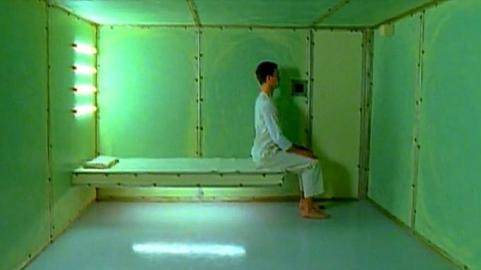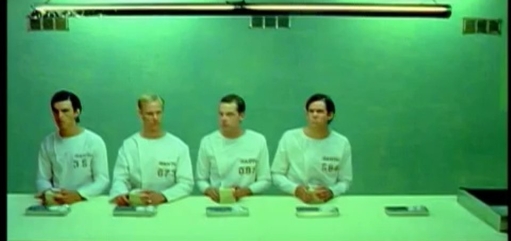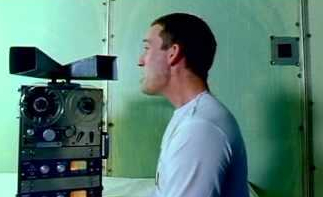An analysis into the filmmaking intricacies of a short film called Bartholomew’s Song.
Bartholomew’s Song: The Musicality of Liberation
Bartholomew’s Song is a short film directed by Destin Daniel Cretton and Lowell Frank and explores themes of the conflict between individuality and collective, and thus between freedom and authority and an exploration of the daily routine through a precise combination of the microelements of film-making (which is to say, cinematography, mise-en-scene, editing and sound).
Sound and sound design are used heavily throughout to exemplify the freedom/authority conflict. The woman’s authoritative voice is heard mostly off-screen, which suggests that the Barth workers are commanded by a mostly unseen figure. By refusing to expose the face of the voice for most the film, a sense of mystery, ambiguity and power surrounds this world’s authority. Indeed, the filmmaker framers the workers through a high angle, taking away their will and power, while framing the speaker, their only window to the figure leading them, in a low angle. Through the framing here, the individuality of the workers is stolen away, as they are all on the same level in the high angle, a collective of worker-drones, that is. Delving further into the speaker’s supremacy, an argument can be made that the speaker itself is a representation of the powerlessness felt by the workers, as they are constantly being usurped by an inanimate object. Mise-en-scene is used, wherein the prop of the speaker holds significance. The workers’ only form of communication throughout the film is through a voice in said prop; the characters in the film never actually converse. This implies that the freedom to discuss and be expressive of one’s self is disallowed by this dictator-like presence.
For the duration of the film, a sense of claustrophobia is created. The film contains shallow space in every location of the film, effectively establishing a miniscule, pressurised environment where the room to walk around or freely roam is restricted. To elaborate, the lack of freedom felt by the workers is exacerbated by the location and set of the film. Continuing, an overall emphasis on claustrophobia is made prevalent by a general tightness held throughout the film, with tight close-ups and a deep focus of f/11 highlighting the reality of the situation and therefore how the characters are completely trapped in these compact spaces.

Diegetic sound is used in the film to emphasise the aforementioned themes of conflict. The musical player Bartholomew finds plays calming, opera music that is both expressive and emotional, while the diegetic woman’s voice on the speaker is calculated and unemotional. Further juxtaposition and contrast is explored in the visual match cut of the music player speakers and the sovereign speakers, creating the idea that both speakers are the only form of communication, but are juxtaposed in what they represent, The music player brings musicality and volume in a world of where sound is discouraged and muffled. Openness is made prominent, highlighted through Barth 467’s staging while singing; Barth faces the audience in a warm, welcoming manner. This stark contrast of the speakers is exaggerated by its colour. The colour gradient throughout the film is an overwhelming green, which reflects the imposing nature of the oppression of the unknown government and white is used to emphasise the calculated, unfeeling world they live in.

We never see primary colours, which are vibrant, reflecting the lack of vibrance in their lives. However, the primary colour of blue adds not only vibrance, but a new splash of colour into Barth 467’s life, the blue being shown through the music player.

The filmmaker also uses the elements of film to foreshadow Barth’s final action against the woman. The repetition of the montage of Barth disposing of the faulty component actually foreshadows the murder of the woman speaker. Inserts and close-ups are fast cut to create excitement in an otherwise drab world. The close-up of the knife suggests a danger, with constant repetitions of this shot during the course of the film implying that the knife and its danger constantly fills Barth’s mind. Pleonastic sounds are used to enhance the sound of the cleaning and placing of the knife, which adds significance as it is the only other object apart from the music player that creates sound from Barth’s actions.
The murder scene demonstrates new-found individuality for Barth. He repeats the similar pattern of the removal of the faulty component, except for the two-shot of him stabbing the woman. The difference now is that, similar to the music player, another primary colour, red is used to bring a raw, new emotion into his life. Indeed, his humanity is highlighted finally by the back and side lighting, which suggests he is humanising and regretful of the murder he had just committed.
Overall, Bartholomew’s song is an incredible example of how filmmaking can comment and elaborate on themes relevant to the real world. The “collective” of the workers, I find, is eerily reminiscent of the world of profession, where everyone works for an unseen boss, an entity dictating one’s wages and ultimately, their lives.
